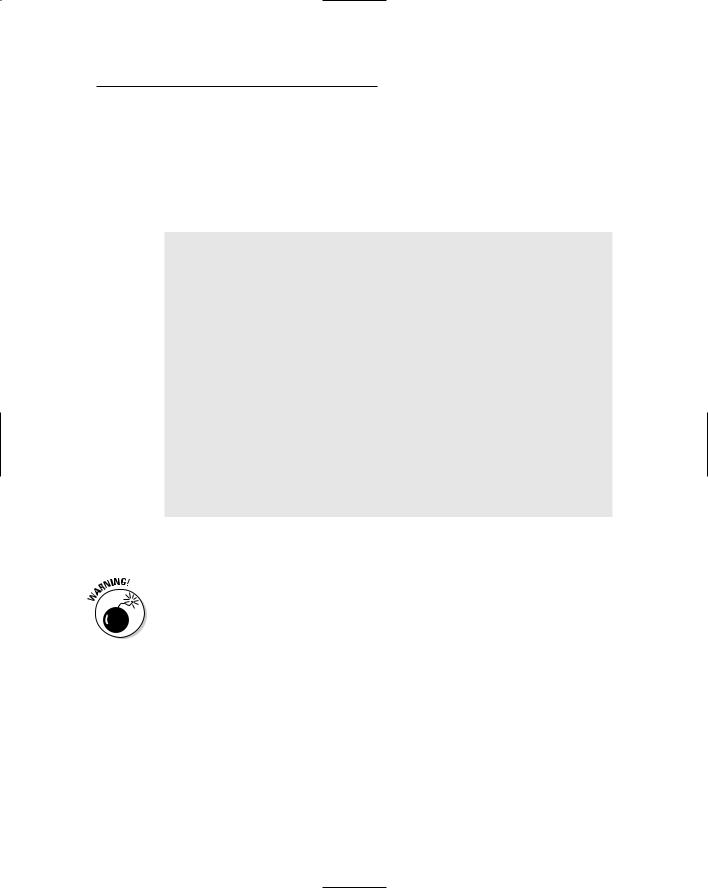
- •Table of Contents
- •Introduction
- •What Is C++?
- •Conventions Used in This Book
- •How This Book Is Organized
- •Part I: Introduction to C++ Programming
- •Part III: Introduction to Classes
- •Part IV: Inheritance
- •Part V: Optional Features
- •Part VI: The Part of Tens
- •Icons Used in This Book
- •Where to Go from Here
- •Grasping C++ Concepts
- •How do I program?
- •Installing Dev-C++
- •Setting the options
- •Creating Your First C++ Program
- •Entering the C++ code
- •Building your program
- •Executing Your Program
- •Dev-C++ is not Windows
- •Dev-C++ help
- •Reviewing the Annotated Program
- •Examining the framework for all C++ programs
- •Clarifying source code with comments
- •Basing programs on C++ statements
- •Writing declarations
- •Generating output
- •Calculating Expressions
- •Storing the results of expression
- •Declaring Variables
- •Declaring Different Types of Variables
- •Reviewing the limitations of integers in C++
- •Solving the truncation problem
- •Looking at the limits of floating-point numbers
- •Declaring Variable Types
- •Types of constants
- •Special characters
- •Are These Calculations Really Logical?
- •Mixed Mode Expressions
- •Performing Simple Binary Arithmetic
- •Decomposing Expressions
- •Determining the Order of Operations
- •Performing Unary Operations
- •Using Assignment Operators
- •Why Mess with Logical Operations?
- •Using the Simple Logical Operators
- •Storing logical values
- •Using logical int variables
- •Be careful performing logical operations on floating-point variables
- •Expressing Binary Numbers
- •The decimal number system
- •Other number systems
- •The binary number system
- •Performing Bitwise Logical Operations
- •The single bit operators
- •Using the bitwise operators
- •A simple test
- •Do something logical with logical calculations
- •Controlling Program Flow with the Branch Commands
- •Executing Loops in a Program
- •Looping while a condition is true
- •Using the for loop
- •Avoiding the dreaded infinite loop
- •Applying special loop controls
- •Nesting Control Commands
- •Switching to a Different Subject?
- •Writing and Using a Function
- •Divide and conquer
- •Understanding the Details of Functions
- •Understanding simple functions
- •Understanding functions with arguments
- •Overloading Function Names
- •Defining Function Prototypes
- •Variable Storage Types
- •Including Include Files
- •Considering the Need for Arrays
- •Using an array
- •Initializing an array
- •Accessing too far into an array
- •Using arrays
- •Defining and using arrays of arrays
- •Using Arrays of Characters
- •Creating an array of characters
- •Creating a string of characters
- •Manipulating Strings with Character
- •String-ing Along Variables
- •Variable Size
- •Address Operators
- •Using Pointer Variables
- •Comparing pointers and houses
- •Using different types of pointers
- •Passing Pointers to Functions
- •Passing by value
- •Passing pointer values
- •Passing by reference
- •Limiting scope
- •Examining the scope problem
- •Providing a solution using the heap
- •Defining Operations on Pointer Variables
- •Re-examining arrays in light of pointer variables
- •Applying operators to the address of an array
- •Expanding pointer operations to a string
- •Justifying pointer-based string manipulation
- •Applying operators to pointer types other than char
- •Contrasting a pointer with an array
- •Declaring and Using Arrays of Pointers
- •Utilizing arrays of character strings
- •Identifying Types of Errors
- •Choosing the WRITE Technique for the Problem
- •Catching bug #1
- •Catching bug #2
- •Calling for the Debugger
- •Defining the debugger
- •Finding commonalities among us
- •Running a test program
- •Single-stepping through a program
- •Abstracting Microwave Ovens
- •Preparing functional nachos
- •Preparing object-oriented nachos
- •Classifying Microwave Ovens
- •Why Classify?
- •Introducing the Class
- •The Format of a Class
- •Accessing the Members of a Class
- •Activating Our Objects
- •Simulating real-world objects
- •Why bother with member functions?
- •Adding a Member Function
- •Creating a member function
- •Naming class members
- •Calling a Member Function
- •Accessing a member function
- •Accessing other members from a member function
- •Defining a Member Function in the Class
- •Keeping a Member Function After Class
- •Overloading Member Functions
- •Defining Arrays of and Pointers to Simple Things
- •Declaring Arrays of Objects
- •Declaring Pointers to Objects
- •Dereferencing an object pointer
- •Pointing toward arrow pointers
- •Passing Objects to Functions
- •Calling a function with an object value
- •Calling a function with an object pointer
- •Calling a function by using the reference operator
- •Returning to the Heap
- •Comparing Pointers to References
- •Linking Up with Linked Lists
- •Performing other operations on a linked list
- •Hooking up with a LinkedListData program
- •A Ray of Hope: A List of Containers Linked to the C++ Library
- •Protecting Members
- •Why you need protected members
- •Discovering how protected members work
- •Protecting the internal state of the class
- •Using a class with a limited interface
- •Creating Objects
- •Using Constructors
- •Why you need constructors
- •Making constructors work
- •Dissecting a Destructor
- •Why you need the destructor
- •Working with destructors
- •Outfitting Constructors with Arguments
- •Justifying constructors
- •Using a constructor
- •Defaulting Default Constructors
- •Constructing Class Members
- •Constructing a complex data member
- •Constructing a constant data member
- •Constructing the Order of Construction
- •Local objects construct in order
- •Static objects construct only once
- •Global objects construct in no particular order
- •Members construct in the order in which they are declared
- •Destructors destruct in the reverse order of the constructors
- •Copying an Object
- •Why you need the copy constructor
- •Using the copy constructor
- •The Automatic Copy Constructor
- •Creating Shallow Copies versus Deep Copies
- •Avoiding temporaries, permanently
- •Defining a Static Member
- •Why you need static members
- •Using static members
- •Referencing static data members
- •Uses for static data members
- •Declaring Static Member Functions
- •What Is This About, Anyway?
- •Do I Need My Inheritance?
- •How Does a Class Inherit?
- •Using a subclass
- •Constructing a subclass
- •Destructing a subclass
- •Having a HAS_A Relationship
- •Why You Need Polymorphism
- •How Polymorphism Works
- •When Is a Virtual Function Not?
- •Considering Virtual Considerations
- •Factoring
- •Implementing Abstract Classes
- •Describing the abstract class concept
- •Making an honest class out of an abstract class
- •Passing abstract classes
- •Factoring C++ Source Code
- •Defining a namespace
- •Implementing Student
- •Implementing an application
- •Project file
- •Creating a project file under Dev-C++
- •Comparing Operators with Functions
- •Inserting a New Operator
- •Overloading the Assignment Operator
- •Protecting the Escape Hatch
- •How Stream I/O Works
- •The fstream Subclasses
- •Reading Directly from a Stream
- •Using the strstream Subclasses
- •Manipulating Manipulators
- •Justifying a New Error Mechanism?
- •Examining the Exception Mechanism
- •What Kinds of Things Can I Throw?
- •Adding Virtual Inheritance
- •Voicing a Contrary Opinion
- •Generalizing a Function into a Template
- •Template Classes
- •Do I Really Need Template Classes?
- •Tips for Using Templates
- •The string Container
- •The list Containers
- •Iterators
- •Using Maps
- •Enabling All Warnings and Error Messages
- •Insisting on Clean Compiles
- •Limiting the Visibility
- •Avoid Overloading Operators
- •Heap Handling
- •Using Exceptions to Handle Errors
- •Avoiding Multiple Inheritance
- •Customize Editor Settings to Your Taste
- •Highlight Matching Braces/Parentheses
- •Enable Exception Handling
- •Include Debugging Information (Sometimes)
- •Create a Project File
- •Customize the Help Menu
- •Reset Breakpoints after Editing the File
- •Avoid Illegal Filenames
- •Include #include Files in Your Project
- •Executing the Profiler
- •System Requirements
- •Using the CD with Microsoft Windows
- •Using the CD with Linux
- •Development tools
- •Program source code
- •Index

Chapter 5: Controlling Program Flow |
73 |
Nesting Control Commands
Return to our PC-screen-repaint problem. Surely it must need a loop struc ture of some type to write each pixel from left to right on a single line. (Do Middle Eastern terminals scan from right to left? I have no idea.) What about repeatedly repainting each scan line from top to bottom? (Do PC screens in Australia scan from bottom to top? Beats me.) For this particular task, you need to include the left-to-right scan loop within the top-to-bottom scan loop.
A loop command within another loop is known as a nested loop. As an exam ple, you can modify the BreakDemo program into a program that accumulates any number of sequences. In this NestedDemo program, the inner loop sums numbers entered from the keyboard until the user enters a negative number. The outer loop continues accumulating sequences until the sum is 0. Here’s what it looks like:
//NestedDemo - input a series of numbers.
//Continue to accumulate the sum
//of these numbers until the user
//enters a 0. Repeat the process
//until the sum is 0.
#include <cstdio> #include <cstdlib> #include <iostream> using namespace std;
int main(int nNumberofArgs, char* pszArgs[])
{
// the outer loop
cout << “This program sums multiple series\n”
<<“of numbers. Terminate each sequence\n”
<<“by entering a negative number.\n”
<<“Terminate the series by entering two\n”
<<“negative numbers in a row\n”;
//continue to accumulate sequences
int accumulator; do
{
//start entering the next sequence
//of numbers
accumulator = 0;
cout << “Start the next sequence\n”;
// loop forever for(;;)
{
// fetch another number int value = 0;

74 |
Part I: Introduction to C++ Programming |
cout << “Enter next number: “; cin >> value;
// if it’s negative...
if (value < 0)
{
// ...then exit break;
}
//...otherwise add the number to the
//accumulator
accumulator = accumulator + value;
}
// output the accumulated result...
cout << “The total for this sequence is “
<<accumulator
<<endl << endl;
//...and start over with a new sequence
//if the accumulated sequence was not zero
}while (accumulator != 0);
// we’re about to quit
cout << “Thank you” << endl;
//wait until user is ready before terminating program
//to allow the user to see the program results system(“PAUSE”);
return 0;
}
Switching to a Different Subject?
One last control statement is useful in a limited number of cases. The switch statement resembles a compound if statement by including a number of dif ferent possibilities rather than a single test:
switch(expression)
{
case c1:
// go here if the expression == c1 break;
case c2:
// go here if expression == c2 break;
default:
// go here if there is no match
}

Chapter 5: Controlling Program Flow |
75 |
The value of expression must be an integer (int, long, or char). The case values c1, c2, and c3 must be constants. When the switch statement is encountered, the expression is evaluated and compared to the various case constants. Control branches to the case that matches. If none of the cases match, control passes to the default clause.
Consider the following example code snippet:
int choice;
cout << “Enter a 1, 2 or 3:”; cin >> choice;
switch(choice)
{
case 1:
// do “1” processing break;
case 2:
// do “2” processing break;
case 3:
// do “3” processing break;
default:
cout << “You didn’t enter a 1, 2 or 3\n”;
}
Once again, the switch statement has an equivalent, in this case multiple if statements; however, when there are more than two or three cases, the switch structure is easier to understand.
The break statements are necessary to exit the switch command. Without the break statements, control falls through from one case to the next. (Look out below!)

76 |
Part I: Introduction to C++ Programming |

Part II
Becoming a
Functional C++
Programmer

In this part . . .
It’s one thing to perform operations such as addition and multiplication — even when we’re logical (AND and OR or other operations). It’s another thing to write
real programs. This section introduces the features neces sary to make the leap into programmerdom.
You’ll find the program BUDGET1 on the enclosed CD-ROM. This largish program demonstrates the concepts of functional programming. You may want to visit this pro gram and its documentation once you’ve mastered func tional programming concepts.
